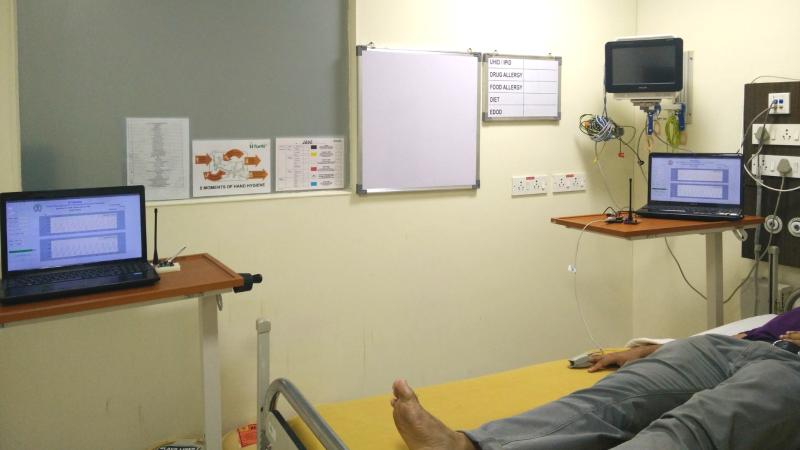
Scientists design low-power, low-cost wearable wireless devices to continuously monitor patient’s health indicators like ECG and EEG
In developing countries like India, the severe shortage of medical professionals, including doctors and nurses, is taking a toll on patients suffering from cardiovascular diseases and respiratory illnesses like pneumonia, as they need constant care and monitoring. Wearable devices that can continuously monitor vital parameters of such patients can save them from life-threatening complications. Recently, Prof Maryam Shojaei Baghini and her team from the Indian Institute of Technology Bombay (IIT Bombay) have developed a wireless, reliable, robust, low-cost and low-power health monitoring system to monitor vital parameters of a patient like the heart rate, oxygen level and the electrical signals of the heart.
The system, called Bio-WiTel, is based on the concepts of telemetry—literally ‘counting (parameters) from a distance’. Telemetric systems for monitoring health consists a wearable sensor, which transmits data wirelessly to a nearby base station, in a frequency that is reserved for medical devices. Funded by the Ministry of Electronics and Information Technology (MeitY), Bio-WiTel is the first full bio-telemetry technology, with custom-built integrated circuit chip, available in India. This study was published in the IEEE Journal of Biomedical and Health Informatics.
Although many commercial wearables available today use Bluetooth to transmit this data, the radiations from such devices can be harmful and cause damage to human tissues if used for an extended period. Bio-WiTel, on the other hand, radiates less than 25 micro-watts of power and is thus harmless to the body when used continuously.
“Our motivation was to develop a hazardless bio-telemetry system, which is as per the recommendations of regulatory authorities, like the Wireless Planning and Coordination Wing in India and the Federal Communications Commission in the USA”, says Dr Abhishek Srivastava who led the study during his PhD at IIT Bombay.
The Bio-WiTel system works in the frequency range of 401-406 MHz. It has a range of about three metres and can transmit the data to a mobile phone, or a dongle connected to a computer. The data thus collected can be accessed over the Internet and hence can help remote monitoring of many patients.
The researchers custom-designed the transmitter, receiver, the communication scheme and the corresponding software of Bio-WiTel so that it had the desired features. They made essential design choices, such as the right data rate that fits the power budget, as a higher data rate would consume more power. They also had an optimal wireless modulation scheme that was robust and reliable. In this case, they used frequency modulation and a data rate that could carry 12 bio-signals simultaneously. They designed the transmitter and receiver as custom fabricated integrated circuits, instead of assembling discrete components, to make the system low cost and low power. Their detailed design considerations included the effect of the packaging and the circuit board, as well as the provision of test points for testing the circuits.
The researchers tested their prototype by transmitting data of the electrocardiogram (ECG) and photoplethysmogram (PPG) with a range of three metres. The ECG measures the electrical signals of the heart while the PPG indicates the pulse and the volume of blood pumped in some areas of the body. They also measured the power consumed by the transmitter, its sensitivity, the power consumption of the receiver and the maximum data and error rate of the system. The results were found to be satisfactory.
The study team also compared Bio-WiTel with seven similar wearable monitoring systems. They found that Bio-WiTel operated at a smaller voltage than others and consumed three to four times less power, although it had a comparable data rate. Its sensitivity was also higher, and its error rate was within the acceptable limits.
Apart from monitoring, the researchers believe that a system like Bio-WiTel can also help in the early diagnosis of many life-threatening diseases as monitoring such patients can be more comfortable.
“A device like this will also help in getting rid of big instruments in hospitals environments, like the Intensive Care Units (ICUs), where vitals of the patients are regularly monitored”, says Dr Srivastava.
Conference papers based on work related to Bio-WiTel have fetched the researchers the best paper award in the International Conference on VLSI Design in 2019 and a nomination for best paper in 2018. The researchers have filed three patents for Bio-WiTel and are hoping to see it commercialised very soon.
“This work has opened up various interesting areas of research, like automation of the system to give real-time feedback to the patients and integration with a technology that draws energy from the patient's body, so that it could operate without a battery”, concludes Dr Srivastava.
Editor's note: Due to a typo, this article has been edited. The Editors regret this error.
Editor's note: The image has been replaced, as per the request of the researchers.





